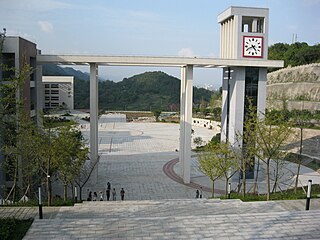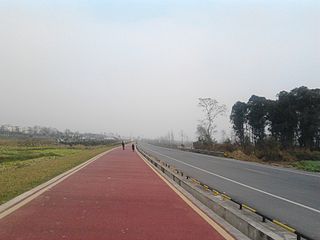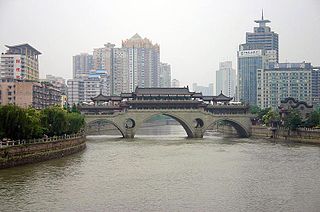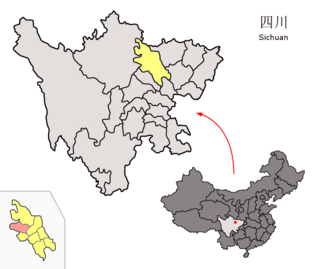
Sichuan is a province in southwest China occupying most of the Sichuan Basin and the easternmost part of the Tibetan Plateau between the Jinsha River on the west, the Daba Mountains in the north, and the Yungui Plateau to the south. Sichuan's capital city is Chengdu. The population of Sichuan stands at 81 million.

Sichuan International Studies University is a public university in Chongqing, China. It is one of the top eight foreign studies universities in China.

Taxkorgan Tajik Autonomous County is a county of Kashgar Prefecture in western Xinjiang, China. The county seat is the town of Tashkurgan.

Ziyang prefecture-level city in eastern Sichuan province, China, with more than 300,000 inhabitants residing in its urban area.

Sichuanese or Szechwanese (simplified Chinese: 四川话; traditional Chinese: 四川話; Sichuanese Pinyin: Si4cuan1hua4; pinyin: Sìchuānhuà; Wade–Giles: Szŭ4-ch'uan1-hua4), also called Sichuanese/Szechwanese Mandarin (simplified Chinese: 四川官话; traditional Chinese: 四川官話; pinyin: Sìchuān Guānhuà) is a branch of Southwestern Mandarin spoken mainly in Sichuan and Chongqing, which was part of Sichuan Province until 1997, and the adjacent regions of their neighboring provinces, such as Hubei, Guizhou, Yunnan, Hunan and Shaanxi. Although "Sichuanese" is often synonymous with the Chengdu-Chongqing dialect, there is still a great amount of diversity among the Sichuanese dialects, some of which are mutually unintelligible with each other. In addition, because Sichuanese is the lingua franca in Sichuan, Chongqing and part of Tibet, it is also used by many Tibetan, Yi, Qiang and other ethnic minority groups as a second language.

Pengzhou, formerly Peng County or Pengxian, is a county-level city under the jurisdiction of Chengdu, the capital of Sichuan province, People's Republic of China, some 19 km (12 mi) northwest of Chengdu. There is an expressway that connects Pengzhou to Chengdu. It is bordered by the prefecture-level divisions of Deyang to the northeast and the Ngawa Tibetan and Qiang Autonomous Prefecture to the north.

Jinjiang District is one of nine districts of Chengdu, the capital of Sichuan province, China. The Jin River flows through it. It is bordered by Longquanyi District to the east, Shuangliu County to the south, Wuhou District to the west, Qingyang District to the northwest, and Chenghua District to the north.

Wuhou District is one of nine districts of Chengdu, the capital of Sichuan province, China. It contains the historic site, Wuhou Temple and Jinli Street. The district is bordered by Jinjiang District to the east, Shuangliu County to the south and west, and Qingyang District to the north.

Beichuan Qiang Autonomous County is a county under the jurisdiction of Mianyang City in northern Sichuan province, China. It is located in an ethnically diverse mountainous region of Sichuan. Its Chinese name literally means "North" (bei) "River" (chuan). Its new county seat is located at Yongchang after the 2008 Sichuan earthquake.

Emeishan is a county-level city in Sichuan province, China. It is administered by the prefecture-level city Leshan. Its population in 1990 stood at 396,445. It is named after Mount Emei, a famous mountain located within its administration.

The 2008 Panzhihua earthquake struck southern Sichuan province, China on August 30 at 16:30:50.5 China Standard Time with a surface wave magnitude of 6.1. It is also cited as the Renhe-Huili earthquake, especially in SCEA reports and early CEA reports. It was not an aftershock of the Sichuan earthquake that occurred several months prior. With more than 400 aftershocks, it caused over 40 deaths, the collapse of 10,000 homes and damage to other infrastructure in the area. The maximum intensity was VIII liedu.

Puge County is a county in the south of Sichuan Province, China. It is under the administration of the Liangshan Yi Autonomous Prefecture.
Daxiangling, or Daxiang Range is a fairly small mountain range in China's Sichuan Province. It runs in the general western and northwestern direction from the famous sacred Mount Emei, and is part of the western mountainous rim of the Sichuan Basin.

The 2014 Kangding earthquake struck Kangding County, Garzê Tibetan Autonomous Prefecture, Sichuan, China, with a moment magnitude of 5.9 on 22 November. The earthquake killed 5 and injured 54 people.
Du Xinyuan (1905–1985) birth name Du Chunren, was a People's Republic of China politician. He was born in Wutai County, Xinzhou, Shanxi Province. He joined the Communist Party of China in 1927, while studying at Beijing Normal University. He was CPPCC Committee Chairman of Sichuan Province. He was a delegate to the 4th, 5th and 6th National People's Congress.

The 2017 Jiuzhaigou earthquake occurred on 8 August 2017, in Zhangzha Town, Jiuzhaigou County, Ngawa Prefecture, Sichuan Province, China. The earthquake was registered at Ms 7.0 and killed at least 25 people in the mountainous region of northern Sichuan.

The Double First Class University Plan or Double Top University Plan is a Chinese government plan conceived in 2015 to comprehensively develop a group of elite Chinese universities and individual university departments into world class universities and disciplines by the end of 2050.


















